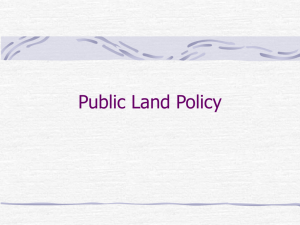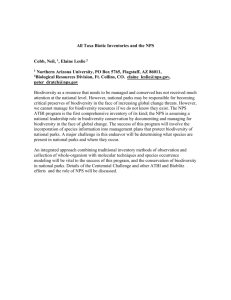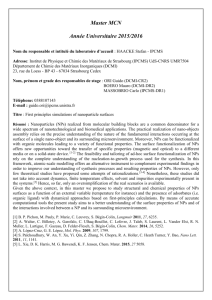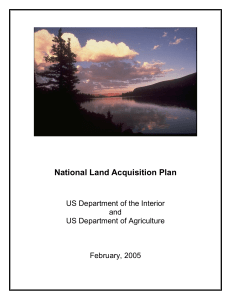Vertical structure - Science & Environmental Policy
advertisement
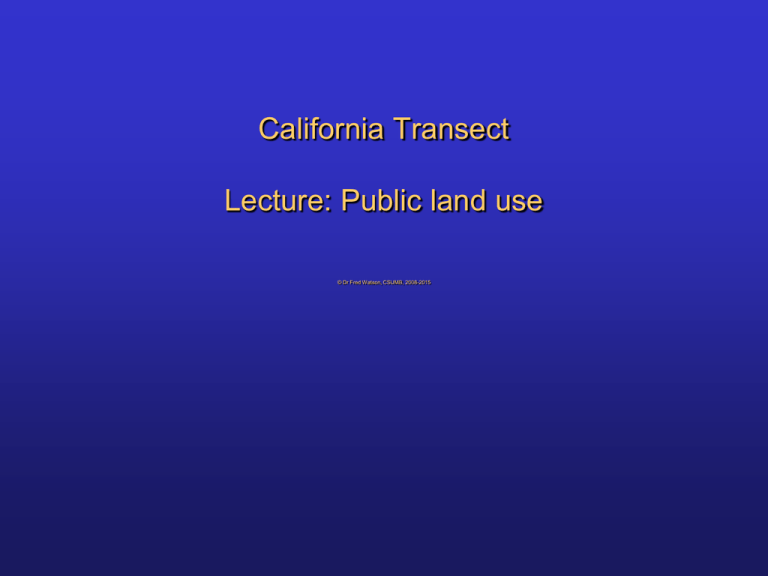
California Transect Lecture: Public land use © Dr Fred Watson, CSUMB, 2008-2015 Outline • Overall message – Public lands are managed for differing purposes – The purpose of management affects the experience of different visitors in different ways – In the future, when you visit land type X, you’ll have a better understanding of its goals for management, and thus a better appreciation (or disdain) for what you see – You can change what you see by advocating for different management within the goals of the designation, or for a different designation altogether • Survey – Who’s been to which public land use types? – And what did you do there? • Federal agencies – and the lands they manage • The mosaic of public land uses through which we’ll travel Survey • Who’s been to, and what did you do at: – – – – – – A World Heritage Site ? A National Park? A National Forest? A National Wildlife Refuge? BLM Lands? An Indian Reservation? – A State Park, State Beach, State Vehicular Recreation Area, etc.? Federal agencies and the lands they manage. Underline indicates the four major land management agencies • Department of the Interior – National Park Service – 79 million acres - est. 1916 (YNP est. 1872) – “Preserve unimpaired...for the enjoyment of...future generations” • • • • • • • • • – U.S. Fish & Wildlife Service – “Conserving the Nature of America” – 95 million acres - est. 1939 • – National Parks National Monuments / Memorials (Can be proclaimed by President) National Rivers / Recreational Areas National Historic Parks / Sites National Battlefields / Military Parks National Trails National Heritage Areas National Seashores / Lakeshores National Parkways 793 National Wildlife Refuges – fishing, hunting – endangered species (including plants) Bureau of Land Management – 262 million acres - est. 1946 • “BLM Lands”- Multiple-use - Livestock & Mining – – Bureau of Reclamation - est. 1907 • – Holds all Indian land in trust for 561 Tribes US Geological Survey- “Science for a changing world” - est. 1879 • • Dams, power-plants, canals – water wholesale & hydro-electricity Bureau of Indian Affairs – est. 1824 • – Includes some National Monuments Not a land management agency Department of Agriculture – Forest Service – “Land of many uses” – Multiple-use – 193 million acres - est. 1905 • National Forests • National Grasslands – Some National Monuments inside National Forests • Department of Energy • National Laboratories • Department of Defense • • • • • • Department of Transportation Department of Commerce Department of Education Department of Health and Human Services Department of Homeland Security Department of Housing and Urban Development Department of Justice Department of Labor Department of State Department of the Treasury Department of Veterans Affairs Independent – NASA • Not a land management agency • • • • • • • Military bases Other land managers and land designations • National Wilderness Preservation System (under the Wilderness Act, 1964) – National Wilderness • – Wild and Scenic Rivers • – • National Trails System (Historic & Scenic) Department of Parks and Recreation • • • • County Parks Local Districts – Monterey Regional Parks District • • • State Parks State Beaches State Vehicular Recreation Areas County governments • Garland Ranch Park Palo Corona Park, etc... Cities – e.g. City of Marina • United Nations Educational, Scientific, and Cultural Organization (UNESCO) • World Heritage sites • 11,000 miles California State Government – • 105 million acres - BLM, FWS, Forest Service, NPS • City Park proposed on 2nd Avenue • • • • • • • • • • • • • • • • • • • • (International Treaty, 1972 - Cultural and Natural) “World Heritage sites belong to all the peoples of the world, irrespective of the territory on which they are located.” Mesa Verde National Park (1978) Yellowstone National Park (1978) Everglades National Park (1979) Grand Canyon National Park (1979) Independence Hall (1979) Kluane / Wrangell-St Elias / Glacier Bay / Tatshenshini-Alsek (1979, 1992, 1994) # * 29 Redwood National and State Parks (1980) Mammoth Cave National Park (1981) Olympic National Park (1981) Cahokia Mounds State Historic Site (1982) La Fortaleza and San Juan National Historic Site in Puerto Rico (1983) Great Smoky Mountains National Park (1983) Statue of Liberty (1984) Yosemite National Park (1984) # Chaco Culture (1987) Hawaii Volcanoes National Park (1987) # Monticello and the University of Virginia in Charlottesville (1987) Pueblo de Taos (1992) Carlsbad Caverns National Park (1995) Waterton Glacier International Peace Park (1995) * National Park Service • Mission – “The National Park Service preserves unimpaired the natural and cultural resources and values of the national park system for the enjoyment, education, and inspiration of this and future generations. The Park Service cooperates with partners to extend the benefits of natural and cultural resource conservation and outdoor recreation throughout this country and the world.” Forest Service • Mission – “Sustain the health, diversity, and productivity of the Nation’s forests and grasslands to meet the needs of present and future generations.” Bureau of Land Management • Mission – “It is the mission of the Bureau of Land Management to sustain the health, diversity and productivity of the public lands for the use and enjoyment of present and future generations.” U.S. Fish and Wildlife Service • Mission – “Working with others to conserve, protect and enhance fish, wildlife, and plants and their habitats for the continuing benefit of the American people.” • Mission of USFWS NWR System – “The mission of the National Wildlife Refuge System is to work with others, to conserve, protect and enhance fish, wildlife, and plants and their habitats for the continuing benefit of the American people.” Bureau of Indian Affairs • Mission – “The Bureau of Indian Affairs is responsible for administering Federal Indian policy; fulfilling its Federal trust responsibilities to American Indians, Tribal Governments, and Alaska Natives; and promoting tribal self-determination and self-governance.” Where can / should you do what? • Hunting – – – – • Fishing – • Best in NPs & NWPSs Good in NFs Often pretty neat in BLM Not in NWRs Birding – • • Everywhere! ...but especially great in NWRs Car camping – NFs and BLM are great Not in NPs generally Not in many State Parks Erecting fences – • Ok in NWPSs (!) Some NPs NFs BLM Dog walking – – • Not in NPs, or NWPSs Horse-riding – – – – • Not in NPs, or NWPSs Fossil hunting – • NPs, NFs, ... Picking flowers – • Not much in NPs Plenty in NFs Prescribed burns – BLM, or private Some NFs Hiking & camping – – – – • • Mining & grazing – – • NF BLM Not common in NPs or NWRs Fighting wildfires – – Ditto, but ok in NPs Mountain biking – – – • NWRs BLM NF Not normally in NPs • Ok in BLM Explosives – DOD and BLM-mining Transect route

